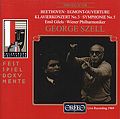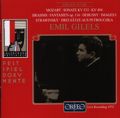ORFEO International
News
October 2011
Emil Gilels 95th Anniversary
We 
C 332 931 B

C 484 981 B

C 523 991 Bwould be doing Emil Gilels an injustice by describing him as a late starter, and yet that is the impression that one occasionally forms because it was at a relatively late date that Gilels, having already made a name for himself in the Soviet Union, conquered the concert halls of the rest of the world. Born in Odessa on 19 October 1916, he was still an adolescent when he gave his first public concerts. He studied in Moscow with the legendary Heinrich Neuhaus and in 1938 won first prize at the Eugène Ysaÿe Competition in Brussels. 
C 608 032 B

C 712 062 IBut at that point the outbreak of the Second World War prevented him, at least for the present, from embarking on a promising international career. Instead he used the time to perfect his technique and work on his repertory both as a soloist and as a chamber recitalist. Among the musicians with whom he appeared as a recitalist were Leonid Kogan, Mstislav Rostropovich and David Oistrakh, who, like him, was one of the first Soviet artists to be allowed to visit the West. By 1955 the time was finally ripe for Gilels’ United States début, but it was to be another fourteen years before he started to appear regularly at the Salzburg Festival. His five recordings on the Orfeo label were all made at the Salzburg Festival. Even on its own term, his début with the Vienna Philharmonic under George Szell is a remarkable document, the all-Beethoven programme centred around the composer’s Third Piano Concerto. Gilels’ solo recital from 1970 finds him effortlessly encompassing a repertory from early Romanticism to the heyday of that movement, starting with Schubert’s Moments musicaux and A minor Sonata D 784 and ending with Liszt’s B minor Sonata. An even greater span in the history of music is covered by Gilels’ 1972 Salzburg programme, in which he displayed a dazzling array of pianistic colours in a repertory ranging from Mozart’s F major Sonata K 533/494 to Brahms’s Fantasies op. 116, the first part of Debussy’s Images and Three Movements from Stravinsky’s Petrushka. In a delightful compilation of Mozart recordings by various pianists in Salzburg, Gilels is represented by Mozart’s Paisiello Variations K 398 and the A minor Sonata K 310. And he is to be heard, finally, in a live recording from the 1971 Salzburg Festival with the Czech Philharmonic under Karl Böhm. (It was also under Böhm that Gilels performed double concertos with his daughter Elena.) On this occasion he is heard performing the Fifth Piano Concerto of Ludwig van Beethoven, a composer with whose works Gilels likewise set standards by which all other pianists were judged.
top |